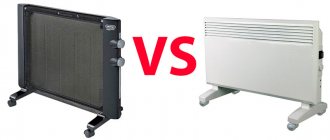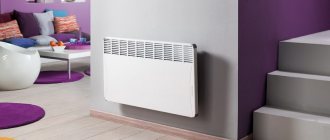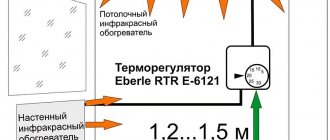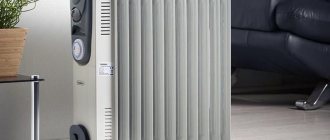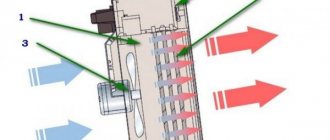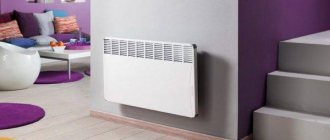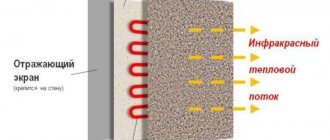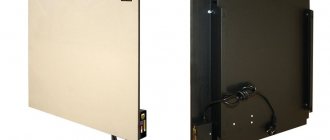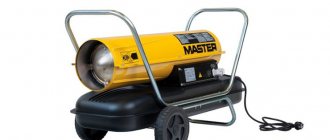The problem of saving resources gradually affects all areas of human life. If you do not save heat and energy today, tomorrow you will have to face a shortage of natural reserves. Modern science is aimed at developing energy-efficient “smart” devices, one of which is a micathermic heater with infrared radiation.
You will learn everything about the design and operating principles of this innovative type of heating devices from the article we presented. We will talk about its varieties, their characteristic differences and selection rules. We will also analyze whether thermal infrared radiation is harmful or beneficial in everyday life.
General information about micathermic heater
A micathermic heater is an electrical device that distributes infrared heat waves. IR heat is electromagnetic radiation that occupies the region of the spectrum between the red edge of light visible to the human eye (with a wavelength of λ = 0.74 μm) and microwave radiation (a wavelength of about 1-2 mm).
The heater has a multilayer design. Each of the layers of non-metals and metals included in it performs a strictly defined function. Some insulate, others concentrate and reflect heat waves. The principle of operation is extremely simple, and the design of a micathermic infrared heater is quite understandable.
Design of a micathermic heating device
The development of the MK heater is based on the achievements of space technology. However, in appearance it looks like a regular convector.
The IR device consists of:
- heating element - a mica plate, with resistive flat elements or nitrochrome wire coils immersed in it;
- an insulator that prevents excessive heating of equipment (most often done using basalt);
- metal body of the device;
- a protective metal grille through which infrared radiation passes;
- stands for supports and rollers for moving.
To control and monitor operation, the heating device is equipped with:
- remote control;
- touch or push-button control panel;
- temperature controller;
- indicator board, which helps to understand the state of the unit;
- power regulator (most models of heaters that are on sale have a power of 1-2 kW).
The main working parts of MK heaters are micanite heaters. They are produced using Micathermik technology. This technology consists of layer-by-layer application of mica onto metal heating elements.
The micanite heater is placed in a housing made of mica. It transports the thermal energy received from the heater to the room being treated. Infrared heat is directed to surrounding objects, and from them is transferred to the room being served. In this case, neither water nor oil coolants are used.
You can see the micanite heater only by disassembling the electrical equipment. But when disassembling the device, it is important not to damage the heater or change its position inside the device. If the contact density is broken, the heating effect will decrease
Micanite is paper pressed from tiny flakes of mica. This mineral, scaly in structure, is quite fragile, its layers are thinned to fractions of a millimeter. Mica has good electrical insulating, thermal conductivity and heat-resistant properties. It is often used in radioelements and capacitors.
The mineral is heated in an extremely short time, reaching 200 degrees or more. Due to the synthetic production of mica, the IR wavelength increases, while the intensity of the radiation decreases.
Mixing micanite with a heat-resistant binder and pressing them produces heat-resistant sheets with good dielectric properties that can be used in heaters. In addition, mica does not release toxic components when heated.
Mica layers insulate the heating element from the rest of the structure and transfer heat. The thickness of the mica plates is carefully selected depending on the overall dimensions of the device. Usually it is no more than 0.03-0.025 mm.
The thermal expansion of mica always coincides with the thermal expansion of the core. Thanks to this, maximum noiselessness during operation is achieved, because All kinds of clicks and knocks inside the device are eliminated.
Between the heating element and the mica plates there are 2 additional layers: inner and outer. The inner layer reflects heat, due to which infrared radiation is completely released into the space chosen for heating. The outer layer is responsible for increasing temperature flows.
The micanite heating element is placed in a metal case with mesh inserts. Infrared radiant heat passes freely through the perforated “shell.” The design is thought out in such a way that the thermal energy supplied by the device is distributed throughout the room with maximum uniformity.
The greatest infrared radiation from micathermic equipment is observed directly in front of the device, this must be taken into account when arranging objects. It is not recommended to install the device opposite the bed or in close proximity to the desktop
In addition to infrared thermal radiation, a noticeable flow of rising warm air spreads through the upper end of the grille (convection method) from the MK heater when it is put into operation, although the body of the device itself does not heat up.
During operation, the unit emits infrared and electromagnetic waves, which are in a range that is safe for living beings. Thanks to this, micathermic heaters can be used in kindergartens or hospitals.
Operating principle of MK heater
The operation of each micathermic heater is based on heat transfer by infrared radiation (80% of total performance) and convection heating by creating air movement due to temperature differences (20%). By combining 2 heating techniques, the highest possible efficiency is achieved.
Those. it heats air volume and objects through infrared radiation from a distance. Thanks to this, heat transfer occurs much faster when compared with a water or oil radiator. After all, an ordinary water, gas or electric convector heats only the air that comes into contact with its ribs.
The MK heater transfers energy to the object with minimal dissipation. The role of an object can be objects, animals, or people. Moreover, after exposure to infrared waves, things and walls themselves become sources of heat and heat the air.
Outside the range of the IR heater, the room practically does not heat up. In this case, the heat flux density decreases with increasing distance between the heater and the object.
However, an IR heater is indispensable if you need to quickly heat up one item in the room. The body of the device itself, insulated with a composition using basalt, does not reach high temperatures (above 60 degrees), which eliminates the possibility of burns due to accidental contact with the unit.
It is best to buy micathermic heaters with a steel casing. Such structures are not afraid of external mechanical influences from impacts and falls. Plus they heat up very quickly
But you cannot dry clothes on a heater, as there is a risk of fire. Some synthetic materials that come into contact with the device may melt or catch fire. The exception is special, improved models equipped with shelves for shoes or folding dryers for clean clothes.
Technically, the operating principle of the elements of a micathermic heater is quite simple. When the device is turned on, the plate begins to heat up. It heats up to 200-400 degrees Celsius and transfers heat to the mica layers.
The electrical energy imparted to the mica plates is transformed into infrared radiation directed at objects near the electrical appliance. This entire process takes a few minutes, and the room becomes warm almost immediately after turning on the equipment.
A small room (up to 20 sq.m.) can be heated with a micathermic device in 10 minutes. When the air in the room reaches the desired temperature, the thermostat in the unit is activated, turning off the heater. The equipment can be configured to automatically maintain a comfortable temperature background in the room.
High energy efficiency and cost-effectiveness are the main features of micathermic heaters. They are characterized by high power, so they consume less electricity by about a third compared to conventional convectors. The efficiency of an infrared heater is about 90%.
Useful additional options
Standard MK heaters have a minimum number of settings, but some of them have various additional elements depending on the modification.
These elements include:
- built-in thermostats that allow you to control multiple air flows;
- liquid crystal displays with special protective functions;
- air ionizers and humidifiers;
- timers, etc.
Many micathermic heaters have the function of protecting the room from freezing. If you activate this option and install the device in an unheated room, it will automatically turn on if the temperature in the room approaches zero.
Also, some heaters are equipped with an IP24 degree of protection, which protects against moisture and prevents the possibility of damage to the device or short circuit if water gets on the equipment.
All additional devices are initially built into the design of the micathermic heater. The exact configuration depends on the technical characteristics of the heater: its power, mounting method and dimensions
What is a micathermic heater
A micathermic heater is an electrical device that is capable of distributing infrared heat waves. Infrared heat is considered electromagnetic radiation, which occupies the region of the spectrum between the generated microwaves and the red edge of visible light.
The heating device is equipped with a multilayer structure. Incoming layers that perform specific functions can be either metallic or non-metallic. One part of them helps to isolate heat waves, others are aimed at their concentration and reflection.
The power of the heaters is in the range of 1500-3000 W. Each IR device is equipped with a mechanical or electronic control type.
Classification by direction of radiation
All micathermic heaters are divided into:
- one-way devices, in which infrared rays are directed only in one direction;
- double-sided devices that radiate heat in both directions on the sides of the product;
- cylindrical units having a circular zone of infrared radiation.
Single-sided heaters can be wall-mounted or floor-mounted. They have a mesh front and back. The back side has small ventilation holes at the bottom.
Double-sided heaters are installed on the floor. They have two working plates that produce infrared rays. The heating plates are equipped with metal mesh. Single-sided and double-sided heaters direct infrared rays horizontally along the floor.
The horizontal supply of IR rays contributes to uneven distribution of heat in the room. With infrared radiation, the warmest air is closest to the floor, which helps keep your feet warm. Higher towards the ceiling it is usually colder.
Heaters should be installed in the coldest parts of the room. However, they are not recommended for use in rooms with high humidity (bathrooms, laundry rooms, showers). In such places, electrical appliances are installed with protection from the effects of moisture suspended in the air.
Heaters of cylindrical or oval shape contain radiators of non-standard configuration (semi-ring or tubular). They can be attached to the ceiling or walls, depending on the features of the structure. Cylindrical heaters are distinguished by a circular zone of infrared radiation.
How to use a micathermic heater correctly
Like any electrical device, an IR heater based on micanites requires compliance with safety precautions during operation:
- Do not connect the battery to an outlet that shows signs of damage;
- the electric heating device should not have direct contact with water, this can lead to severe electric shock, even death;
- The power cord should not be twisted or pulled, and should not be laid under carpets and rugs;
- It is prohibited to place electrical appliances with heating elements near objects that can easily ignite;
- Do not cover the electric battery with a cloth; only special stands should be used for drying clothes;
- It is not recommended to connect devices to the device that are not provided for in the model, for example, timers;
- It is unacceptable for foreign objects to get inside the device body; it is necessary to periodically clean it of dust;
- You should not attempt to repair the electric battery yourself.
By following these simple rules, you will be able to use this type of infrared heater for a long time without risk to health and property.
Common Use Cases
Infrared heaters can be used in indoor and outdoor areas. With their help you can heat a terrace, balcony, nursery or living room. Also, MK devices with the ability to heat by convection are appropriate to prevent the appearance of ice on the staircase.
Because when heating a room with infrared rays, there is no less oxygen in the air (and it does not dry out), IR devices are recommended for use in rooms where small children, asthmatics or allergy sufferers live.
But micathermic systems serve not only private owners; they are in demand in:
- medicine for the treatment of patients with blood flow disorders, cardiovascular pathologies, migraines and frequent acute respiratory infections;
- veterinary medicine for the treatment of animals;
- massage rooms (massage under infrared radiation helps reduce weight);
- offices to destroy viruses and bacteria.
Using micathermic heaters, you can create thermal curtains over panoramic windows and other translucent glass structures that have poor thermal insulation properties.
To kill bacteria, the micathermic heater should be left on for several hours. However, it is not recommended to use this device solely for disinfection, because... the device does not kill all viruses, fungi and mold that are in the room
Pros and cons of a micathermic heater
Anyone who has encountered an advertisement for a new product for the first time can conclude that there is nothing better than a heater with a new type of “mico-heater”. In fact, as experts say, the best micathermic heater is the one that is still being designed in the future.
Due to the low temperature of the lamellas, the mycothermal heater creates a thermal field with a radius of only one meter
Positive aspects of the micathermic heating method
The advantages of micathermic heating can be explained in three points:
- Firstly, most of the energy passes into the air through radiation, but due to the low temperature, the flow intensity is low, so the heater heats the air at a distance of one and a half to two meters from the heating element;
- Secondly, the mica-protected surface does not oxidize and does not dry out the air, as happens with convection and infrared heaters;
- Thirdly, the relatively cold surface of the ceramic heater does not collect dust, and accordingly, there is no characteristic unpleasant odor in the room air.
For example, compare the amount of dust falling on a water heating radiator and on an electric convector. The layer of dust collecting on convectors is 3-4 times greater than on the surface of the battery. Each additional layer of paint or dust reduces the heater's efficiency.
The micathermic heater is absolutely safe for others
Since the heat flux emitted by the heater is relatively low density, long-term stay nearby does not cause severe discomfort, as, for example, in front of an infrared emitter. At the same time, most of the heat is dissipated directly in the air, and not on surrounding objects, so you don’t have to worry too much about furniture, wallpaper, toys scattered on the floor in front of the electric heater.
Disadvantages of a low temperature heater
Of the significant disadvantages, only two of the most important can be noted. First of all, a micathermic heater is a modern high-tech equipment, so it must be handled with extreme caution and care; you must not drop it, try to repair it, or change anything inside. Any fall to the floor may result in failure.
The second drawback is related to the operating mode of the micathermic heater. It is clearly not suitable for very quickly heating up a room. Despite the low thermal inertia, and the heating element begins to produce heat almost a few seconds after switching on, the power and density of the heat flow is clearly not enough to quickly warm up a summer cottage or country house that has cooled down in the fall.
Advantages and disadvantages of micathermic heaters
The advantages and disadvantages of a micathermic heater are determined by the operating principle and design of the equipment.
The device has an impressive number of advantages, which include:
- energy efficiency;
- high heating speed;
- compact body;
- stylish appearance;
- light weight (depending on the type of unit varies in the range of 3-4 kg);
- safety;
- maintaining a healthy indoor microclimate;
- minimal background noise during operation, etc.
Also, a micathermic heater prevents the development of microbial and viral microflora, and also kills fungus in the room. However, this device does not have a bactericidal effect and cannot be used along with ultraviolet lamps for quartz treatment.
During operation of the infrared device, no accumulation of air mass is formed under the ceiling. Thanks to this, IR equipment is perfect for rooms with high ceilings, because... heat will not dissipate over the entire area. But through the holes in the casing of the unit a lot of dust gets in, which is almost impossible to get out of there.
When you turn on the device, dust and dirt become hot and smell bad. The smell will disappear only when the dust burns completely. It is noteworthy that a micathermic heating device will emit such a stench whenever it is left turned off for a long time.
Rating of micathermic heaters
If the question is choosing a suitable model that not only provides heating and heating of the room, but also has an elegant design, then it is best to turn to DeLonghi products. For example, the DeLonghi HMP1500 model.
The black stylish body on wheeled supports will look great in any interior. Power -1.5 kW, weight - 5 kg, has built-in shutdown protection when falling
Any Italian micathermic heaters, even the most budget models, but actually produced in the EU, enjoy an invariably high reputation, both in design and in operation.
Among the budget models, we can recommend Chinese products assembled under license from EU countries:
- Model VES-MX Compact and inexpensive micathermic heater is suitable for installation on a wall in a country house, garage, workshop or in any other room where you have to deal with the cold. Power 1.5 kW, weight -3.4 kg, price 4100-4500 rubles;
- VES-MX5, a very lightweight and at the same time stylish electric heater, is recommended for use in small office spaces. Weight - 2 kg, power 1.3 kW, heating occurs only on one side of the case, has a built-in automatic switch off when falling;
- AIC DFHT-6305Р is used for heating fairly spacious rooms, for example, lobbies and halls. The micathermic heater is made according to a non-standard design in the form of a vertical column, with a circular direction of heat radiation. Power 2 kW, with touch control and adapter for switching on additional heating sections. Weight about 8 kg, designed to work for 30,000 hours;
- Polaris RMN2095 is ideal for small-sized residential premises, for example, a summer house or a one-room apartment. The power of the heating element is 2 kW, weight is 4 kg, it is possible to program the air temperature that the micathermic heater will maintain automatically. Price 6500 rub.
One of the most popular models of micathermic heater
Almost all wall and floor heaters are equipped with a very short cord, rarely exceeding 150-160 cm, so when choosing a location it will be necessary to install additional electrical wiring. In cheap micathermic models, the automation is built on bimetallic and thermoplastic relays, so during operation you can often hear the mechanism for disconnecting the heater from the network clicking.
How to choose the right model?
When purchasing a micathermic heater, you need to take into account the characteristics of the room in which it will be placed. Approximately for every 10 sq.m. housing you need to take 1 kW of power without taking into account heat loss.
If this will be the only heat source, you need to choose a device with more power. If you buy an infrared heater for a small summer house, you can choose a device with a power of no more than 70 W per 1 sq.m.
In reality, it is difficult to heat a room with only one micathermic heater, because... you need to think very carefully about the location of the device. Maximum heating of air and objects will be observed only at a distance of a couple of meters from the front panel.
Before purchasing an MK heater, you need to ask the seller for all the necessary accompanying documentation, incl. hygienic certificate for the isolator. It is better to buy equipment with a basalt insulator, which can be used even in the food industry (marks about this are usually present in the hygiene certificate).
Any electrical equipment needs timely and complete care. Due to their structure, micathermic heaters must be regularly vacuumed and wiped with a damp cloth to remove accumulated dust. Before cleaning the device, turn off the power.
Is infrared waves harmful to the body a myth?
Infrared waves are traditional electromagnetic radiation, similar in structure to solar rays. The harm and benefits of infrared radiation are determined by the depth of penetration of these waves into the skin.
There are 3 types of heating devices depending on the wavelength and incandescent temperature of the heating element:
- devices with maximum heating up to 300 degrees and wavelength 50-200 microns;
- devices heating up to 600 degrees and with a wavelength of 2.5-50 microns;
- heaters with heating up to 800 degrees and a wavelength of 0.7-2.5 microns.
Those. The higher the filament temperature of the device, the more short waves will be emitted. For an ordinary healthy person, heat waves with a length of about 9.6 microns are safe. Manufacturers indicate the range of infrared radiation in the technical device data sheet.
Information about the range of infrared radiation can be found in the accompanying documentation for the heaters or on the product box. The absence of this information indicates significant violations on the part of the manufacturer
Typically it varies between 2-10 microns. In this case, the intensity of IR radiation depends on the characteristics of the heated surface (especially its emissivity). The most powerful radiation comes from a heated black object.
Any prolonged targeted infrared radiation has a bad effect on the human body, which is expressed in:
- drying out of the skin;
- decreased vision (long-term exposure increases the risk of developing cataracts);
- disruption of the structure of cell membranes (typical of short infrared waves), etc.
It is especially dangerous to install a powerful ceiling heater in a room with low ceilings. In this case, infrared rays will constantly heat a person’s head and can lead to the development of all kinds of diseases.
But these infrared heaters can only cause real harm if the flow is constantly directed at a person. Ideally, the devices should be installed so that the heaters give off their heat to walls or pieces of furniture, but are not directed at a person.
The heater should not be directed at the person all the time. Infrared radiation is only useful in small quantities
However, in Japan and Europe, entire institutes are developing methods to combat cancer based on the influence of infrared radiation. Scientific research has proven that infrared waves, reaching 14-20 cm inside the skin, effectively detoxify cells.
This occurs due to selective hyperthermia, increasing biochemical circulation and eliminating congestion in tissues. The result of using radiation depends on correctly selected circuits, and a micathermic heater is absolutely safe for health if you use common sense when installing it.
Popular models of Polaris micathermic heaters
Korean manufacturer Polaris produces a wide range of household appliances. There are not only heaters and air conditioners, but also kitchen appliances from a refrigerator to a mixer, audio and video equipment, medical and cosmetic devices, sports equipment and much more. The company has been operating since 1995 and today is one of the largest manufacturers of household appliances for various purposes in the world.
In Russia alone there are more than 250 Polaris service centers in all major cities. Domestic buyers highly appreciate the quality of the Korean manufacturer’s products, including climate control equipment. These devices are popular because of their affordable prices - they are affordable for buyers with average incomes.
Each segment has an extensive model range with a variety of functionality, so choosing a device that suits your requirements will not be difficult.
But this barrel of honey also has its own fly in the ointment. Or rather, there are two of them. The first is the relatively short warranty period for the products. The company deliberately takes this step, since a developed network of service centers allows it to repair products without spending money on their complete replacement. And the second spoon is the lack of a branded online store. Polaris products are sold in online markets, but not every city has their representative offices. For some reason, the website of this company is not being improved to meet the immediate needs of consumers, so it is not particularly popular.
Now let’s turn specifically to Polaris micathermic heaters and consider the most popular models in this segment.
Micathermic heater Polaris PMH 2095 – at the peak of popularity
This device has a power of 2000 watts and can heat a room of 24 m². It is installed on the floor, has a universal design and an anti-tip system. Available in black and silver, it has power adjustment in 2 levels. The cost of the product (all prices are as of July 2021) is 4,999 rubles.
Polaris PMH
Video review of the Polaris RMN 2095 micathermic heater.
Model Polaris PMH 1594 – customer opinion
The Polaris PMH 1594 micathermic heater can be purchased for an average of 4,000 rubles. It differs from the previous model with a lower power of 1500 W and, accordingly, a smaller heating area. Like other floor heaters, it is equipped with an emergency shutdown when tipping over.
Polaris PMH
Infrared battery Polaris PMH 2005
The lightweight and compact micathermic heater Polaris PMH 2005 will cost you 5,300 rubles. It will heat 30 m². Two power levels allow you to adjust the heating intensity. An overview of the advantages of this device in a short video.
Polaris PMH
Heating with Polaris PMH 1596 rcd
The micathermic heater with target=»_blank» rel=»noopener noreferrer»>convector heating Polaris PMH 1596 rcd has electronic control with an LED display and a control panel. This battery is capable of heating from both sides, so it is better to place it not against the wall, but in the middle of the room. Three heating elements inside the device are capable of heating 24 m² of area. The unit costs about 5,200 rubles.
Polaris PMH
Heater Polaris PMH 2085 for home and garden
And last on our list, but not the least in quality, is the Polaris PMH 2085 micathermic heater. Simple, with mechanical control and all protective functions, it is perfect for a country house or city apartment. It runs on 220 Volts, moves easily on wheels and has a light indicator. It will cost only 4,500 rubles. Here's what customers write about it.
Polaris PMH 2085
Conclusions and useful video on the topic
The video provides an overview of the MK-1501 micathermic heater - innovative equipment, using an example of which you can understand the principle of operation of infrared heaters:
A micathermic heater is an innovative electrical device that is used for heating rooms. Its functioning is based on infrared radiation from micanite elements. The equipment is characterized by high inefficiency, energy efficiency, compactness and versatility.
Would you like to share your own experience in choosing an infrared heater? Do you have useful information on the topic of the article? Please write comments in the block below, post photos, and ask questions.
